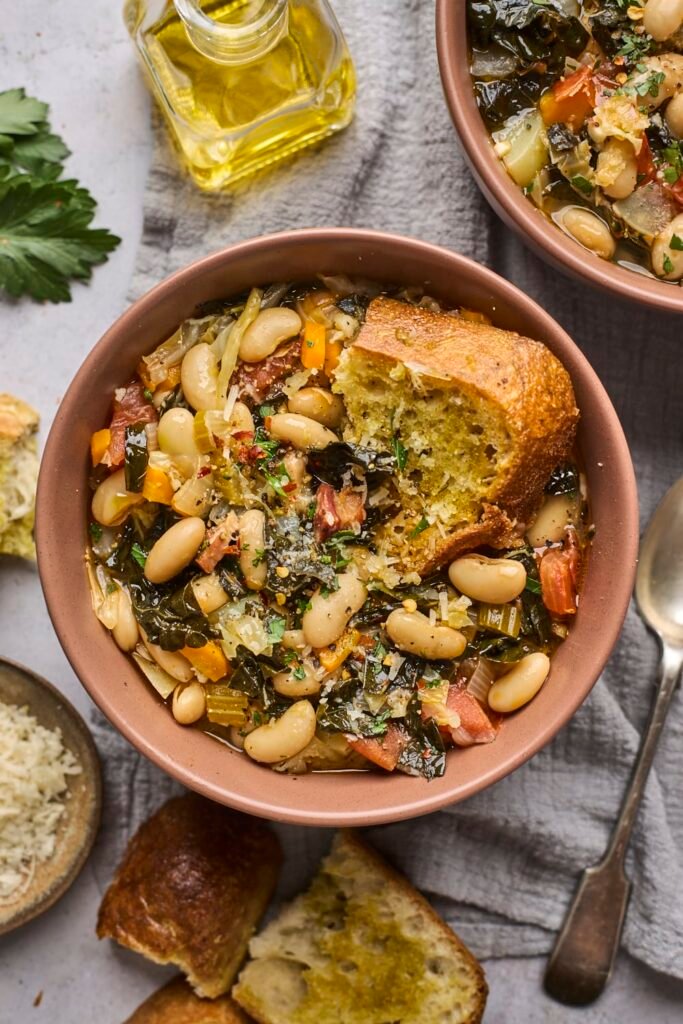Ribollita is a classic Italian soup originating from Tuscany, known for its rustic charm and hearty flavors. The name “ribollita” translates to “reboiled” in English, reflecting its traditional preparation, where the soup is cooked, allowed to cool, and then reheated. This process enhances the melding of flavors, resulting in a comforting and satisfying dish that embodies the essence of Tuscan cuisine.
Ingredients

The beauty of ribollita lies in its simplicity and reliance on fresh, seasonal vegetables. The key ingredients include:
- Beans: Cannellini beans, a staple in Tuscan cuisine, provide creaminess and protein.
- Vegetables: A medley of vegetables such as carrots, celery, onions, and kale add depth and nutrition.
- Tomatoes: Crushed tomatoes or tomato puree contribute acidity and richness.
- Bread: Stale, rustic bread, preferably a country-style loaf, gives ribollita its characteristic thickness and heartiness.
- Herbs: Fresh herbs like thyme, rosemary, and bay leaves infuse aromatic notes.
- Broth: Vegetable broth forms the base of the soup, enhancing the overall flavor.
Preparation Steps
- Soak the Beans: If using dried cannellini beans, soak them overnight in water. Alternatively, canned beans can be used for convenience.
- Prepare the Vegetables: Dice onions, carrots, and celery. Sauté them in olive oil until softened. Add minced garlic for an aromatic base.
- Add Tomatoes: Incorporate crushed tomatoes or tomato puree to the vegetables. Allow them to simmer, intensifying the flavors.
- Beans and Broth: Drain and rinse the soaked beans, then add them to the pot. Pour in vegetable broth, creating a robust foundation for the soup. Season with salt, pepper, and the selected herbs.
- Kale and Bread: Toss in chopped kale, a nutritional powerhouse. Break the stale bread into chunks and stir it into the soup, letting it absorb the liquid and thicken the mixture.
- Simmer and Cool: Allow the ribollita to simmer on low heat for at least an hour. The slow cooking process allows the ingredients to meld. Once cooked, let it cool, as the reheating step is essential to the dish’s final character.
- Reheat and Serve: The following day, reheat the ribollita, and witness the magic of the flavors intensifying. Serve it hot, drizzled with extra virgin olive oil and accompanied by a sprinkle of grated Parmesan cheese.
Variations and Tips
- Vegetarian or Vegan Options: Ribollita traditionally includes vegetables and beans, making it an excellent choice for vegetarians. To make it vegan, ensure that the bread used does not contain dairy.
- Customization: Feel free to customize the soup based on seasonal produce. Add zucchini, potatoes, or any other favorite vegetables to enhance the flavor profile.
- Bread Selection: Choose a hearty, day-old bread with a robust crust. This type of bread absorbs the broth without becoming overly mushy, providing the ideal texture to the ribollita.
- Garnishes: Elevate the presentation by garnishing each bowl with a drizzle of high-quality extra virgin olive oil, a sprinkle of freshly grated Parmesan cheese, and a dash of black pepper.
Conclusion
Ribollita embodies the spirit of Tuscan cooking—a celebration of simplicity, fresh ingredients, and time-honored traditions. This wholesome soup not only warms the body but also nourishes the soul, making it a cherished dish in Italian kitchens and a comforting addition to any table around the world.

